Diving Kingston Wreck is a captivating underwater adventure situated off the coast of Kingston. Nestled in the crystal-clear waters of the Red Sea, this dive site offers a depth of 28 meters, making it accessible to both novice and experienced divers. The Kingston Wreck, with its historical significance, reveals the passage of time through its weathered structure as it rests on the ocean floor. Surrounded by vibrant coral reefs and teeming with marine life, the wreck serves as a living museum beneath the waves.
Divers can explore the intricate details of the sunken vessel, capture mesmerizing photographs, and witness the transformation of a once-active ship into an artificial reef supporting a diverse ecosystem. Whether drawn by history, marine biodiversity, or the thrill of underwater exploration, diving Kingston Wreck promises an unforgettable journey through time and nature.
Diving at the Red Sea Quick Information
- Wet Suit: Skin, or 3mm
- Water Temperature: 28-30 Celsius
- Current: Most of the wrecks in the Red Sea have mild to very strong currents – typically currents are during ascent and descent and will not be as strong once sheltered by the wreck
- Max Depth: 24-28m
About the Kingston
This boat was originally launched in 1871, and was the model of an Iron Screw Steamer.
The Kingston spent his career as a coal carrier.
In 1881, the Kingston departed on the final voyage from Cardiff, England with a final destination of Port of Aden.
The wreck of Kingston occurred due to the ship drifting off course. The Kingston ran into Shag Rock, which would be the cause of the ship sinking – eventually. First, the ship was stuck on the coral. At the order of the Captain, the crew began jettisoning cargo from the ship in order to lighten the overall load of the ship. However, this proved not to be enough.
Two ships came by, one offered to take the crew – which the Captain declined. The second assisted in trying to pull the ship from the coral – but also ineffective.
Finally, the ship began taking water. Half the crew was picked up by another passing vessel, and the remainder of the crew remained on the reef with the ship.
The ship finally took on enough water to weigh the vessel enough for it to slip off the reef and sink to the ocean floor.
Dive Season at the Red Sea
The Red Sea dive season is a year-round delight for underwater enthusiasts, offering diverse experiences and vibrant marine life. The best time to explore the underwater wonders of the Red Sea can be broken down by seasons.
In the winter months, from December to February, the northern Red Sea experiences cooler temperatures, making it a popular destination for divers seeking a comfortable escape. While water temperatures may be slightly cooler, ranging from 21 to 25 degrees Celsius (70 to 77 degrees Fahrenheit), the clear visibility underwater remains remarkable. The winter season provides an excellent opportunity to witness schools of fish and explore coral formations in tranquil conditions.
As spring emerges from March to May, the Red Sea dive season enters a period of transition. The water begins to warm up, ranging from 23 to 27 degrees Celsius (73 to 81 degrees Fahrenheit), and marine life becomes more active. The visibility remains excellent, creating optimal conditions for divers to encounter a variety of underwater species. Spring is characterized by calm seas and moderate temperatures, making it an ideal time for those who prefer milder weather.
Summer, from June to August, heralds the peak of the Red Sea dive season. During this time, water temperatures rise to 26 to 30 degrees Celsius (79 to 86 degrees Fahrenheit), creating a haven for marine biodiversity. The summer months offer the best visibility, with clear waters providing a stunning backdrop for underwater exploration. Divers can expect warm temperatures both above and below the surface, making it an ideal season for those seeking a tropical diving experience.
As autumn approaches in September to November, the Red Sea dive season enters another transition phase. Water temperatures gradually cool down, ranging from 24 to 28 degrees Celsius (75 to 82 degrees Fahrenheit), and marine life activity continues. While visibility may slightly decrease compared to the summer months, the Red Sea remains an attractive destination for divers looking to explore its unique underwater landscapes.
Overall, the Red Sea dive season caters to divers throughout the year, with each season offering its own charm. Whether you prefer warmer summer temperatures, milder spring and autumn conditions, or a peaceful winter escape, the Red Sea ensures a memorable diving experience with consistently clear waters and diverse marine ecosystems.
Recommended Certifications for Kingston
Compared to the other wrecks in the North Red Sea such as Thistlegorm, Giannis D and Chrisoula K this will be one of the easiest dive experiences.
This is primarily due to the fact that diving Kingston wreck is one of the shallower ones – only reaching a max of 17m.
However, for the rest of the diving experience, divers should come prepared with an Advance Water certification for the depths. If you want to feel more comfortable during the dives as well – then a wreck certification can assist in that.
What to Spot at Kingston
Exploring the Kingston Wreck and the general Red Sea promises an awe-inspiring encounter with a diverse array of marine life, making these underwater destinations a paradise for underwater enthusiasts. At the Kingston Wreck, the sunken vessel serves as an artificial reef, attracting a plethora of marine species that have made it their home. Divers can expect to witness colorful coral formations adorning the wreck, providing shelter to an abundance of marine life. Schools of tropical fish, including vibrant parrotfish, angelfish, and butterflyfish, create a mesmerizing spectacle as they navigate the intricate structures of the sunken ship.
The Red Sea, in general, is renowned for its rich biodiversity, and diving into its depths reveals an underwater world teeming with life. Vibrant coral reefs, such as those found in the famous Ras Mohammed National Park, harbor an impressive array of marine species. Divers can encounter majestic reef sharks, graceful manta rays, and even the elusive dugong. The Red Sea’s warm waters nurture a variety of fish species, from the iconic clownfish to the majestic lionfish.
The Kingston Wreck and the Red Sea are also known for attracting larger pelagic species. Divers may have the opportunity to encounter barracudas, tuna, and, depending on the season, even whale sharks. The Red Sea’s nutrient-rich waters contribute to the thriving marine ecosystem, creating an underwater paradise for photographers and nature enthusiasts alike.
In addition to the marine life visible during daylight dives, the Red Sea comes alive at night with nocturnal creatures. Night dives reveal a different perspective, with the chance to spot fascinating creatures such as octopuses, cuttlefish, and various crustaceans.
Overall, diving at the Kingston Wreck and in the general Red Sea offers a captivating exploration of underwater realms, where divers can marvel at the beauty of diverse marine ecosystems and encounter a spectacular array of sea life that makes these destinations truly extraordinary.
Photo Spots at the Kingston Wreck
There is not too much left of the vessel over such a long period, and due to the fact that the boat had a wooden deck – meaning that a good portion has now completely deteriorated. However, there are still some great photo spots at the Kingston to include:
- Propeller: on the stern of the boat the propeller is still intact. With most wreck dives this is a great photo spot for divers.
- Spare Propeller: Moving from the stern over to the main hull of the vessel you will pass the spare propeller, which is another great photo opportunity.
- Boilers: This is one of the unique aspects of diving Kingston compared to the other wrecks of the Red Sea, visiting the boilers. The sides have rusted away and now divers can see inside of them and the corals and fish that now reside inside.
What to Expect Diving Kingston
Kingston can potentially be a difficult dive as the location can be known to have strong currents. Otherwise, as previously stated this dive is one of the shallower dives available at the Red Sea.
The usual dive plan is to start at the stern of the boat. This is the deepest portion of the boat. Exploring the popular photo locations, and then completing the dive by swimming along Shag Rock – a reef wall.
This dive also offers the opportunity to spot some larger ocean life such as hawksbill turtles. This is a frequent location to see them – especially when diving on the reef wall of Shag Rock after completing the wreck portion of the dive.
Depths:
- Stern: 17m
- Bow: 5-10m
How to Dive Kingston
Most people will visit Kingston through a liveaboard. Egypt is known for having a Northern route and a Southern Route.
Taking a Northern route liveaboard is mostly known for the wreck dives as there are numerous wrecks littering the seafloor in the northern portion of the Red Sea.
This area alone has several wrecks, making it a stop for wreck dives so that divers can explore upwards of three wrecks that crashed into this reef wall.


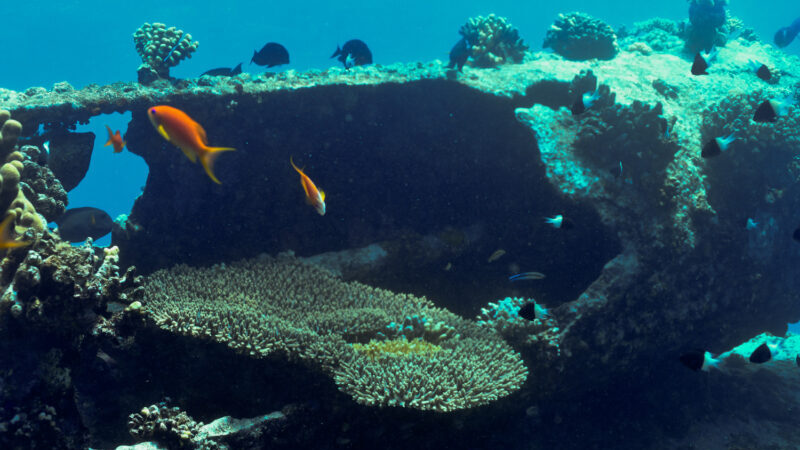

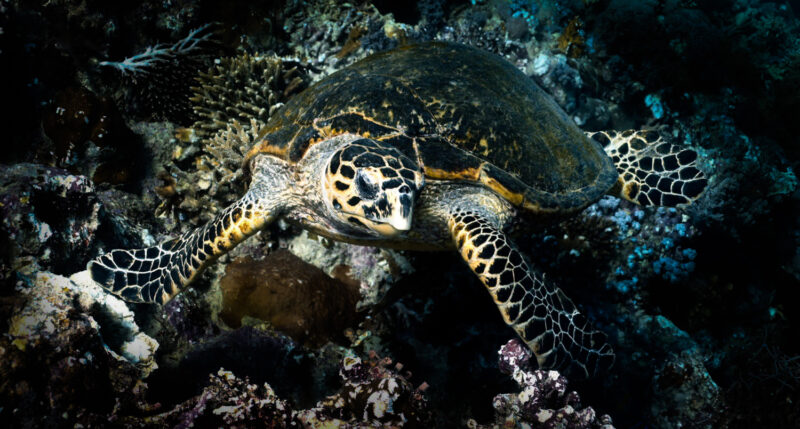
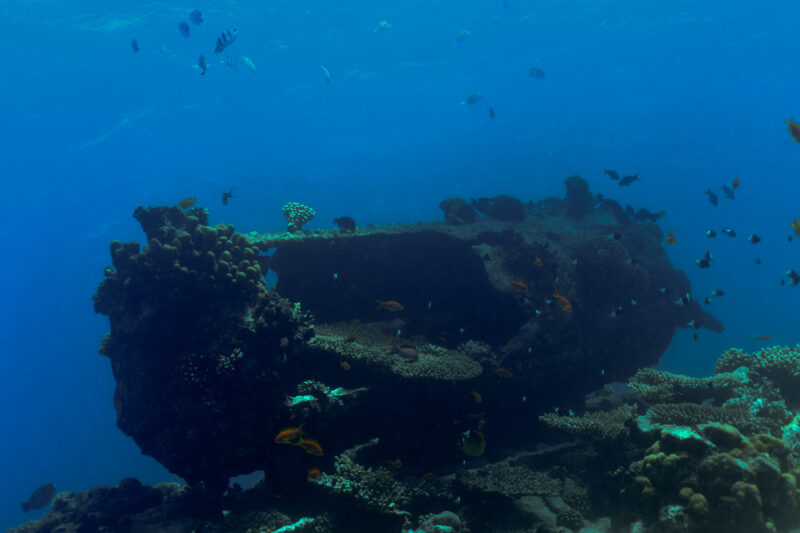
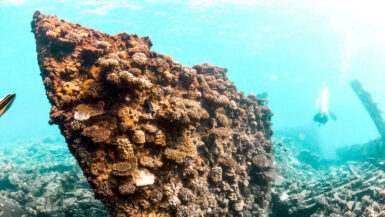
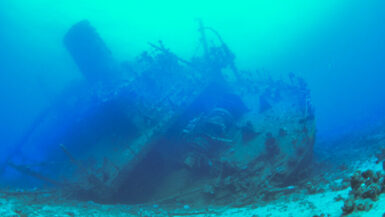
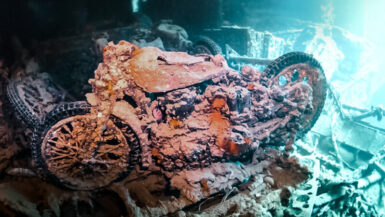
[…] PreviousNext […]
[…] Kingston is diving history. The oldest wreck in the Red Sea, there is little that remains other than the […]
[…] CHECK OUTDiving Kingston Wreck […]